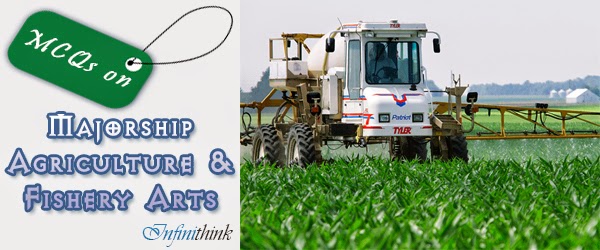Majorship LET Reviewer
 |
| LET Reviewer for Agriculture and Fishery Arts / TLE |
PRACTICE TEST IN AGRICULTURE & FISHERY ARTS
(AQUACULTURE / INLAND FISHERIES)
(AQUACULTURE / INLAND FISHERIES)
1. It refers to the quantity of organisms produced under a given situation per unit of space, time and efforts.
A. Standing crop
B. Production
C. Algal Bloom
D. Cycle of Production
2. An Animal that captures or preys upon other animals for its food known as
A. Predator
B. Nuisance
C. Parasite
D. Competitor
3. It refers to the straining or overtaxing the ability of fish to easily adjust to changing environment conditions.
A. acclimatization
B. stress
C. recovery
D. treatment
4. It is the process of replenishing water lost through evaporation and seepage.
A. Pond draining
B. pond preparation
C. pond freshening
D. pond flushing
5. This is the regular or orderly change from one style of community to another.
A. biological food chain
B. ecological succession
C. material removed
D. ecological balance
6. It is a collective term for all the small suspended organisms that passively drift and float in the water.
A. lumot
B. lab-lab
C. benthic organism
D. plakton
7. The scientific name of milkfish (bangus), the national fish is_______
A. Clarias batrachus
B. Caranx armatus
C. Chanos Chanos
D. Cyprinus carpio
8. The process of releasing fish in a body of water, like fish pond or lake is called________
A. acclimatization
B. stocking
C. thinning
D. transferring
9.It is the quantity of an organism, fauna or flora in a specific ecosystem made at a time of observation.
A. materials removed
B. production rate
C. quantity production
D. standing crop
10. It refers to the process of adjusting the fish to its new environment.
A. stocking
B. acclimatization
C. migration
D. sampling
11. it refers to a complex association of small bottom-dwelling plant and animal organisms that occur as a brownish, greenish or yellowish mat near the pond bottom.
A. nektons
B. detritus
C. lab-lab
D. algae
12. the combination of raw materials to satisfy the established nutrient requirements of the species and age of fish is known as
A. feed formulation
B. feed additive
C. feed stuffs
D. preservatives
13. It is the general index of the efficiency of conversion of a feed into flesh.
A. feed conversion ratio
B. Feed frequency
C. feed efficiency
D. feed consumed
14. The name given to a sudden mass development of unicellular algae, the water getting a green appearance like vegetable soup is
A. red tide
B. algal bloom
C. intoxication
D. asphyxiation
15. It refers to a collective term covering all materials used to control, destroy or mitigate plants.
A. pesticide
B. disinfectant
C. drugs
D. cure
16. Poisonous substance produced by certain species of mold (aspegillus sp.)
A. aflatoxin
B. mimosine
C. red tide
D. algal bloom
17. Causes toxicity of shellfish and finfish due to the presence of dinoflagellate.
A. algal bloom
B. aflatoxin
C. red tide
D. intoxication
18. Refers to a series of processes by which an animal takes in and utilizes food nutrients for maintenance, growth, reproduction and other productive functions.
A. nutrition
B. feeding
C. predation
D. feed formulation
19. It is the amount of feed (wet or dry) being fed daily to the fish.
A. daily feed ration
B. fish biomass
C. feed conversation
D. feeding frequency
20. A disorder with specific cause and recognizable sign and symptoms is called
A. cyst
B. epidemic
C. disease
D. lession
21. The method of reproduction which is done without the interference of man in the organism’s reproductive cycle is known as
A. stripping
B. cross breeding
C. natural method
D. artificial method
22. It is the mating of individuals that are related to each other by ancestry.
A. hybridization
B. cross breeding
C. inbreeding
D. copulation
23. It is a stage at which a fish has just been hatched usually with sizes from 1-2.5 cm
A. fry
B. larva
C. fingerling
D. juvenile
24. It is the method of fish reproduction which involve the interference or aid of man accomplished by injecting hormone or pituitary materials obtained from another fish of the same species of family.
A. eyestalk ablation
B. natural method
C. artificial method
D. external method
25. The number of eggs spawned by the female fish is termed as
A. egg mass
B. fecundity
C. fertilized eggs
D. zygote
26. It refers to marine fishes which migrate to freshwater areas to spawn.
A. catadromous species
B. diurnal species
C. anadromous species
D. omnivorous species
27. It refers to fishes feeding on plants only
A. herbivorous
B. carnivorous
C. omnivorous
D. pelagic feeders
28. It is a culture system which utilizes limited area with very high investment and adopts modern techniques of production.
A. extensive system
B. Semi-extensive system
C. intensive system
D. traditional system
29. A course undertaken to create the best conditions for natural fish food growth and to completely eradicate unwanted species in pond.
A. pond freshening
B. pond fertilization
D. pond lining
C. pond preparation
30. It utilizes wide area with only minimal capital and very low production.
A. extensive culture
B. semi-intensive culture
C. intensive culture
D. modular system

Answers:
ReplyDelete1. A
2. A
3. A
4. C
5. B
6. D
7. C
8. D
9. C
10. B
11. D
12. A
13. C
14. B
15. A
16. A
17. D
18. A
19. A
20. C
21. D
22. B
23. C
24. C
25. A
26. A
27. A
28. C
29. B
30. C